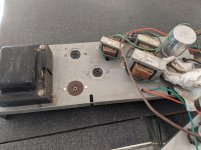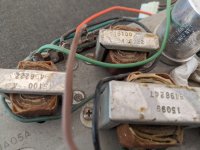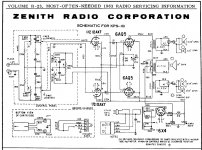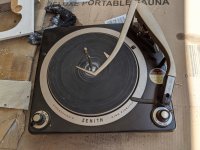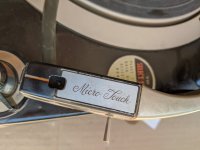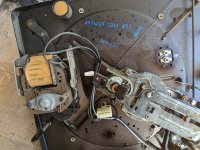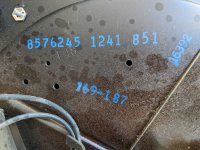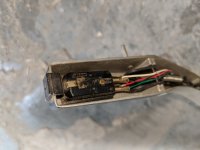I picked up a Zenith KPS 80 suitcase record player and pulled the amp. The output transformers are quite small. I'm guessing the amp's output is ~2 watts per channel. I don't mind leaving things as they are, but I'm wondering if getting larger output transformers is a reasonable idea. If so, what do I need to look for, and do I need to change anything else?
It's got three output transformers; it has a larger speaker that uses the larger transformer. I'm not sure what I'll do with it, but it appears to be for added bass.
I know enough to keep myself safe and to ask questions. I'm going to change the electrolytic caps, but depending on the reply I get (or don't get), I'll decide if I'll do anything else to it down the road.
Thanks,
Mike
It's got three output transformers; it has a larger speaker that uses the larger transformer. I'm not sure what I'll do with it, but it appears to be for added bass.
I know enough to keep myself safe and to ask questions. I'm going to change the electrolytic caps, but depending on the reply I get (or don't get), I'll decide if I'll do anything else to it down the road.
Thanks,
Mike
Attachments
How many leads do those transformers have? If some only have two leads,
then they're filter inductors.
then they're filter inductors.
1 rectifier and 2 output pentodes - 6X4--6AQ5-6AQ5 -no AF stage ?
Not very sensitive, if so I would like to see the circuit diagram it should be interesting.
It must have used a ceramic cartridge .
Having said that and looking it up on the web --surprise-surprise ! it looks like a Stereo player .
IF that is the case then the two small transformers are the output transformers and the large one is a choke-----but if anybody thinks differently OR has a circuit diagram ?
Not very sensitive, if so I would like to see the circuit diagram it should be interesting.
It must have used a ceramic cartridge .
Having said that and looking it up on the web --surprise-surprise ! it looks like a Stereo player .
IF that is the case then the two small transformers are the output transformers and the large one is a choke-----but if anybody thinks differently OR has a circuit diagram ?
Thanks for that Alan I was scratching my head (wood shavings ) trying to work out the audio logic.
With the high values of the input controls it looks like it uses a ceramic cartridge.
Also all 3 transformers are audio types a bit more elaborate than a normal UK portable 50,s/ early 60,s record player.
I have several Dansette & other types of UK players at home.
With the high values of the input controls it looks like it uses a ceramic cartridge.
Also all 3 transformers are audio types a bit more elaborate than a normal UK portable 50,s/ early 60,s record player.
I have several Dansette & other types of UK players at home.
This circuit was somewhat common in the early midrange consumer radiograms. The market asked for multiple speakers, increased output and stereo, but a cost cutting measure was needed to meet the price. This amplifier does have two small output transformers for midrange and tweeter, and a single bigger transformer for the woofer. Some German radio manufacturers implemented a variation of this idea: the mono/stereo switch also inserts a extra triode in the audio path and operates a few rerouting on the output transformer primary wires, this way when the output is mono the amplifier works as push-pull with increased power.
Restoring the Zenith amplifer as-is only makes sense if a 2+1 speaker configuration is wanted. Loudness and tone control are tailored to a ceramic cartridge output, so they must be removed or reworked to get a pleasant sound with modern sources. A filter choke should probably be added in series to the 2W 10K resistor to decrease the hum.
I guess that the underside of the chassis is built with ceramic and paper capacitors directly tied to the tube sockets, and random wire routing. The way I personally deal with this kind of generic low value amplifiers is to strip the chassis to bare metal, refinish (or discard) it, and then rebuild the amplifier with a new circuit, saving only the transformers, tubes (if they check good) and maybe some switches and potentiometers. It only needs a little extra time but the finished work is nice to look and there is minimal risk of humming/buzzing/crackling noises due to degraded tube sockets and poor wiring.
Restoring the Zenith amplifer as-is only makes sense if a 2+1 speaker configuration is wanted. Loudness and tone control are tailored to a ceramic cartridge output, so they must be removed or reworked to get a pleasant sound with modern sources. A filter choke should probably be added in series to the 2W 10K resistor to decrease the hum.
I guess that the underside of the chassis is built with ceramic and paper capacitors directly tied to the tube sockets, and random wire routing. The way I personally deal with this kind of generic low value amplifiers is to strip the chassis to bare metal, refinish (or discard) it, and then rebuild the amplifier with a new circuit, saving only the transformers, tubes (if they check good) and maybe some switches and potentiometers. It only needs a little extra time but the finished work is nice to look and there is minimal risk of humming/buzzing/crackling noises due to degraded tube sockets and poor wiring.
This circuit was somewhat common in the early midrange consumer radiograms. The market asked for multiple speakers, increased output and stereo, but a cost cutting measure was needed to meet the price. This amplifier does have two small output transformers for midrange and tweeter, and a single bigger transformer for the woofer. Some German radio manufacturers implemented a variation of this idea: the mono/stereo switch also inserts a extra triode in the audio path and operates a few rerouting on the output transformer primary wires, this way when the output is mono the amplifier works as push-pull with increased power.
Restoring the Zenith amplifer as-is only makes sense if a 2+1 speaker configuration is wanted. Loudness and tone control are tailored to a ceramic cartridge output, so they must be removed or reworked to get a pleasant sound with modern sources. A filter choke should probably be added in series to the 2W 10K resistor to decrease the hum.
I guess that the underside of the chassis is built with ceramic and paper capacitors directly tied to the tube sockets, and random wire routing. The way I personally deal with this kind of generic low value amplifiers is to strip the chassis to bare metal, refinish (or discard) it, and then rebuild the amplifier with a new circuit, saving only the transformers, tubes (if they check good) and maybe some switches and potentiometers. It only needs a little extra time but the finished work is nice to look and there is minimal risk of humming/buzzing/crackling noises due to degraded tube sockets and poor wiring.
Thanks for the insight. It looks like the best thing to do if I want to rebuild it is to rebuild it as is, including the speaker arrangement. How likely is it I would find speakers that would work with this? The originals are pretty well dried out.
Thanks,
Mike
The 2+1 channel system is still popular on small speakers. As quick check, I would try bookshelf speakers with by-wiring option. Left and right woofers could be connected in parallel to the common low frequency channel.
I think I'm just going to put it back together after changing the electrolytics and cleaning the pots. It's not in horrible shape and doesn't smell like it's ever been around smokers. I'll replace the ribber idler wheel and order a new needle for it too. I pulled the "bass" speaker and it was in rough shape from me pulling it. Pretty badly deteriorated. I repaired the holes with modge-podge and tissue paper and gave the rest of the cone a thin layer. The satellites looked OK, so I added a little polyfill behind then to see how it sounds. I had to partially disassemble it to get the "bass" speaker out, but I was gentle and it is reinstalled and the glue is drying on the pieces I had to remove.
If I find the idler wheel and needle, I'll probably order them and get it back to original shape. I'm not sure what I'll do with it, but it's a fun project. I'm not really a flipper, so putting it on eBay doesn't excite me. It belonged to the father of the lady who sold it to me, so maybe she'd like it back as something to remind her of her Dad.
I see the Needle Doctor closed, so any suggestions where to get a needle and idler?
Thanks,
Mike
If I find the idler wheel and needle, I'll probably order them and get it back to original shape. I'm not sure what I'll do with it, but it's a fun project. I'm not really a flipper, so putting it on eBay doesn't excite me. It belonged to the father of the lady who sold it to me, so maybe she'd like it back as something to remind her of her Dad.
I see the Needle Doctor closed, so any suggestions where to get a needle and idler?
Thanks,
Mike
Try-
Find a New Turntable Stylus for Various ZENITH Cartridges Listed By ZENITH Cartridge Number. | Turntable Needles
Good condition models sell for several 100 $$$ on eBay so it might be worth repairing
Find a New Turntable Stylus for Various ZENITH Cartridges Listed By ZENITH Cartridge Number. | Turntable Needles
Good condition models sell for several 100 $$$ on eBay so it might be worth repairing
Try-
Find a New Turntable Stylus for Various ZENITH Cartridges Listed By ZENITH Cartridge Number. | Turntable Needles
Good condition models sell for several 100 $$$ on eBay so it might be worth repairing
Thanks!
Now my question is how do I know which needle to get. I'm sure there is a part/model number to use in the pictures, but I don't know which or where. Any help?
Thanks.
Thanks.
Attachments
I not been able to find the Zenith part number so far , I know its a ceramic stereo cartridge , the actual deck is somewhat like the British Dansette of the same era and would be held in place with a spring clip .
That website also sells parts for record players .
That website also sells parts for record players .
I not been able to find the Zenith part number so far , I know its a ceramic stereo cartridge , the actual deck is somewhat like the British Dansette of the same era and would be held in place with a spring clip .
That website also sells parts for record players .
Hi Duncan2,
I've been looking through the website you linked but haven't been able to identify which parts I need. I'll email them to see if they can tell me. Thanks much for the link and help!
Mike
- Home
- Amplifiers
- Tubes / Valves
- Changing output transformers?
